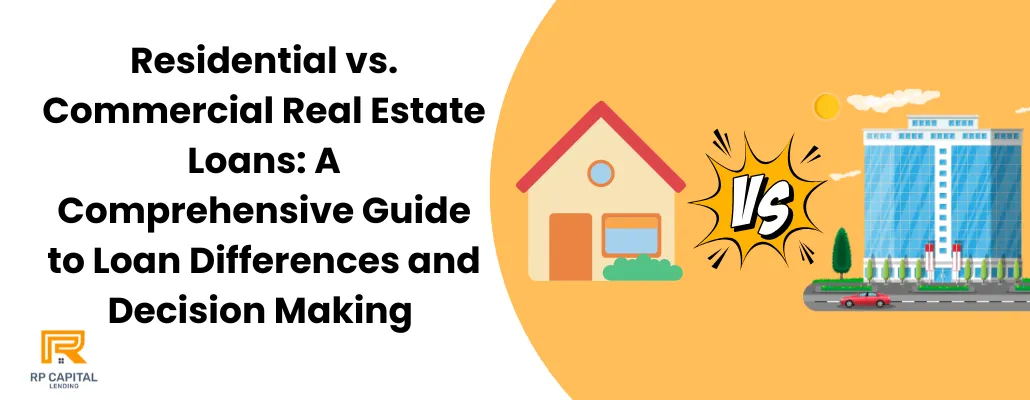Blog

Residential vs. Commercial Real Estate Loans: A Comprehensive Guide to Loan Differences and Decision Making
Real estate financing is a complex yet crucial aspect of property acquisition. Whether it's a cozy home or a sprawling commercial complex, understanding the nuances of different loan types is key. Residential loans, typically sought by individuals, offer a path to homeownership. In contrast, commercial loans cater to businesses and investors eyeing larger properties for economic purposes.
This article demystifies these two loan types, helping you navigate the intricate world of real estate financing. From interest rates to loan terms, we delve into the critical differences and considerations, ensuring you're equipped with the knowledge to make informed decisions.
Overview of Real Estate Loans:
Real estate loans are financial tools enabling individuals or entities to purchase property. Essentially, these loans are categorized into residential and commercial types, each serving distinct purposes. Residential loans are primarily for individuals purchasing homes, offering various programs like conventional, FHA, and VA loans.
On the other hand, commercial real estate loans are for business purposes, involving properties like office buildings, retail spaces, and industrial facilities. Understanding these categories is vital in navigating real estate financing, as each has unique terms, rates, and eligibility criteria, reflecting the varying levels of risk and investment involved.
Distinctive Features of Residential Loans:
Residential loans are characterized by their consumer-centric nature. They are typically more accessible, with lower down payments and more flexible credit requirements, catering to individual homebuyers. These loans often come with government backing through FHA or VA loans, providing additional security and benefits like lower interest rates.
The application process is generally more straightforward, focusing on the borrower's credit history and ability to repay. Residential loans also offer various repayment plans, including fixed-rate or adjustable-rate mortgages, providing options to suit different financial situations and preferences.
Key Aspects of Commercial Real Estate Loans:
Commercial real estate loans are structured around the business potential of the property. These loans are larger in scale and involve higher risks, leading to more stringent eligibility criteria. Lenders evaluate the property's income-generating potential, requiring detailed business plans and financial projections. Interest rates are typically higher, reflecting the increased risk. Moreover, commercial loans often have shorter terms and balloon payments, emphasizing the investment's short-term profitability. Borrowers usually need to have a solid business background and substantial collateral to secure these loans.
Interest Rates Comparison:
Interest rates in real estate loans play a pivotal role in determining the overall cost of borrowing. Residential loans often enjoy lower interest rates due to government backing and the perceived lower risk of individual borrowers. In contrast, commercial loans bear higher rates, reflecting the heightened risk associated with business investments.
These rates are influenced by various factors, including market trends, the borrower's creditworthiness, and the property's potential. It's crucial for borrowers to understand these differences, as they significantly impact the loan's affordability and the investment's viability.
Loan Term Lengths: Residential vs. Commercial:
The term length of a real estate loan is a critical factor in financial planning. Residential loans typically offer longer terms, often up to 30 years, allowing for manageable monthly payments over an extended period. This longer amortization period makes homeownership more accessible to a broader audience.
Conversely, commercial loans usually have shorter terms, ranging from 5 to 20 years. The shorter duration aligns with the investment nature of commercial properties, focusing on quicker returns. Borrowers must consider these term lengths in their investment strategy and financial planning.
Down Payment Requirements:
Down payment requirements significantly differ between residential and commercial loans. Residential loans, especially those with government backing, can have lower down payments, sometimes as low as 3.5%. This accessibility is key in promoting homeownership. In contrast, commercial loans typically require larger down payments, often 20% to 30% of the property’s value.
This higher upfront investment is due to the increased risk and larger loan amounts associated with commercial properties. Prospective borrowers need to evaluate their financial capacity to meet these requirements, as they directly impact loan eligibility and affordability.
Understanding the Approval Process:
The loan approval process varies significantly between residential and commercial loans. For residential loans, the focus is on the borrower's credit score, income stability, and debt-to-income ratio. Lenders assess the individual's ability to repay the loan, with less emphasis on the property itself.
In contrast, commercial loan approvals hinge on the property's profitability and business viability. Lenders require detailed business plans, cash flow projections, and often, a proven track record in business. This thorough evaluation ensures the investment’s feasibility and the borrower's capability to handle the financial obligations.
Risk Assessment in Loan Types:
Risk assessment is a fundamental aspect of the lending process. In residential loans, the risk is primarily based on the borrower's financial stability and credit history. Lenders assess the likelihood of timely repayments, with the property serving as collateral. For commercial loans, the risk assessment is more complex.
Lenders evaluate the property’s potential to generate income, market conditions, location, and the borrower's business acumen. The higher stakes involved with commercial investments necessitate a more rigorous risk assessment process, directly influencing loan terms and conditions.
Impact of Market Trends on Loan Types:
Market trends significantly influence both residential and commercial real estate loans. Economic fluctuations, interest rate changes, and real estate market dynamics can affect loan availability, terms, and viability. For residential loans, market trends can impact housing affordability and mortgage rates, affecting buyers' purchasing power.
In the commercial sector, these trends can alter property values, investment attractiveness, and loan terms. Understanding these market dynamics is crucial for borrowers, as it helps in making informed decisions and timing their investments effectively.
How to Choose the Right Loan for Your Needs:
Selecting the right real estate loan requires careful consideration of one’s financial situation, property goals, and market conditions. For residential borrowers, factors like loan term, interest rate, and down payment options must align with their long-term financial stability and homeownership goals.
Commercial borrowers must consider the investment's viability, their business plan's strength, and the loan's impact on their overall financial strategy. Seeking professional advice, comparing different loan options
Tips for Loan Application Success:
Securing a real estate loan requires more than just meeting basic eligibility criteria. For residential loans, maintaining a good credit score, having a stable income, and minimizing debt are key factors. Demonstrating consistent savings and choosing a property within your budget can also enhance approval chances.
For commercial loans, having a robust business plan, strong financial projections, and relevant industry experience are essential. Demonstrating the property’s potential for income generation and having significant collateral can greatly influence lender confidence. Being well-prepared, organized, and transparent throughout the application process can significantly improve the likelihood of success.
The Future of Real Estate Loans:
The landscape of real estate financing is continually evolving, influenced by economic trends, technological advancements, and regulatory changes. In the residential sector, we may see more flexible and innovative financing options, catering to a diverse range of borrowers.
The commercial loan market might experience shifts towards more sustainable and community-focused projects, reflecting broader societal and environmental trends. Technological advancements like AI and blockchain could streamline the application process and improve risk assessments. Staying informed about these changes is crucial for both current and prospective borrowers, as it will impact how they approach real estate financing in the future.
Conclusion:
Understanding the differences between residential and commercial real estate loans is crucial for making informed financial decisions. Each type of loan has its own set of rules, risks, and rewards, tailored to the specific needs of the borrower and the nature of the property. By comprehensively exploring these aspects, individuals and businesses can navigate the complexities of real estate financing more effectively. Whether you're a first-time homebuyer or a seasoned investor, knowledge is power in the world of real estate loans.
FAQ Section:
1. What are the main differences between residential and commercial real estate loans?
Residential loans are typically for individual homeowners and have longer terms and lower interest rates, while commercial loans are for business properties, with shorter terms and higher rates.
2. Can I get a commercial loan for a residential property?
Generally, no. Commercial loans are intended for properties that generate income, like office buildings or retail spaces, not for personal residences.
3. What factors affect the interest rate of a real estate loan?
Factors include the type of loan, the borrower's creditworthiness, market trends, and the property's potential for income generation (for commercial loans).
4. Is it harder to qualify for a commercial real estate loan?
Yes, typically, because these loans are larger and riskier, lenders require more stringent financial assessments and a solid business plan.
5. Can market trends significantly impact real estate loan terms?
Absolutely. Economic conditions, interest rate fluctuations, and real estate market dynamics can all influence loan availability, terms, and overall cost.
.
RP Capital Lending is a d.b.a of RP Capital Partners Inc (NMLS # 2469193) | Privacy Policy
Copyright © 2022. All Rights Reserved.
Disclaimer: Loans only apply to non-owner occupied properties. Rates, terms and conditions offered only to qualified borrowers, may vary upon loan product, deal structure, other applicable considerations, and are subject to change at any time without notice.

